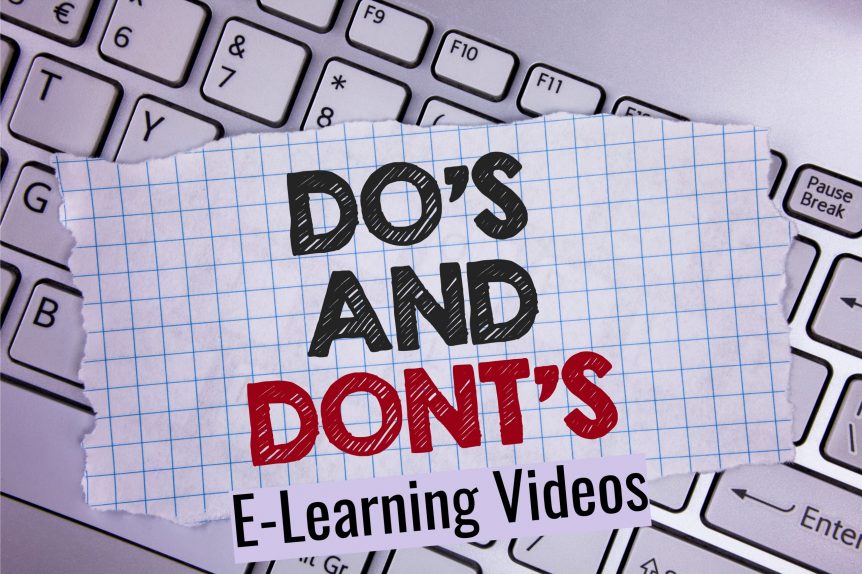The Dos and Don’ts of E-Learning Videos
Videos add variety to your e-learning courses, and they can be the most effective method available for presenting certain types of information. Videos are also highly engaging, plus most people prefer to watch a video rather than read a long block of text.
How do you maximise the effectiveness of e-learning videos? What should you add, what should you omit, and how do you make the videos you create as good as possible?
Here are our Dos and Don’ts for e-learning videos.
Do Make the Video Personal, Conversational, and Informal
The last thing you want in an e-learning video is something that is stuffy and overly formal. This applies even if you work in an industry where being serious and reserved is part of your day-to-day.
Instead, the videos in your e-learning courses should be personable so learners can better relate to them. This will also enhance overall levels of satisfaction in the learning experience.
Don’t Do It on the Cheap
Making your videos informal and conversational doesn’t mean you can do them on the cheap. You are not producing a TikTok video, but a professional video aimed at helping you achieve important business goals. So, invest properly in video production.
Do Include Presenters
Presenters will help facilitate the learning process and they provide a personal connection to learners. As a result, presenters make videos more engaging, so you should include them where possible.
Don’t Let Presenters Dominate the Spotlight
While including presenters can improve your e-learning videos, presenters that are distracting will do the opposite. In particular, you need to make sure presenters don’t try to steal the spotlight by offering over-the-top, overly quirky, or jarring performances.
Do Ensure Your Video is Accessible on Multiple Devices
Most people in Saudi Arabia and the UAE use multiple devices as part of their day to day working routine. This includes computers and mobile devices. As a result, e-learning courses are typically designed to be responsive, so they work on any device. The same applies to videos, i.e. they should play on a variety of different devices.
Don’t Ignore Load Times
It’s not enough, however, to ensure your video technically works on all devices as you also need to consider load times. This is because many of the people accessing your e-learning course on a mobile device will do so using a mobile connection rather than through broadband.
The slower connection speeds on mobile can make it difficult to watch videos that haven’t been optimised for size. This will interrupt the learning experience and frustrate those completing your course.
Do Add Production Elements
Product elements such as intro screens, outro screens, background music, and text overlays showing speaker names will make your e-learning video more professional.
Don’t Include Loud and Distracting Background Audio or Unnecessary Effects
It’s important you don’t go overboard with production elements, however. This particularly applies to background music which can be incredibly off-putting if it’s too loud or sounds out of place.
You should also avoid adding unnecessary visual effects, particularly those that don’t enhance the learning experience and help you achieve your training goals.
Do Create a Storyboard
Creating a storyboard before you take out a camera to shoot the video will ensure the video has a clear narrative and covers all the elements you need to cover. A storyboard can also help you identify potential issues with the video or improvements you can make. It is much cheaper and easier to make these changes at the storyboard stage than it is once you’ve started making the video.
Don’t Go Off on Tangents
Keep the content on your storyboard tight, however. There is always a temptation to add more, to provide additional detail, to include a relevant but separate topic. Tangents like these will distract learners and detract from the effectiveness of the video.
Do Make the Video Valuable to the Learning Process
You shouldn’t include video in your e-learning course for the sake of having a video. While the benefits of using videos in e-learning are compelling, you should only include them when there is a clear reason for doing so.
In other words, the videos you include should enhance the learning process and improve the skills, knowledge, and abilities of the learners completing your course.
Don’t Use Video for In-Depth Detail
While the above point is true, it is important you don’t go into too much detail on the topic in your video. If the topic requires significant amounts of detail, you need to consider whether a video is the right way of presenting the information.
Too much detail will make your videos confusing, plus they can make videos longer than they should be.
The best approach is to focus on a single topic and to keep the video as short as possible to cover that topic.
E-Learning Videos – Getting It Right
Simply creating a video and adding it to your e-learning course is not enough. Instead, you need to make sure you make the video as good as possible, always keeping the learner and the goals of the training course at the forefront of your mind. The above Dos and Don’ts will help you achieve this.
